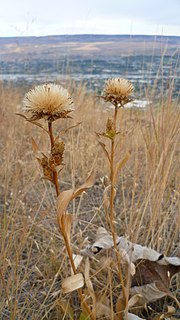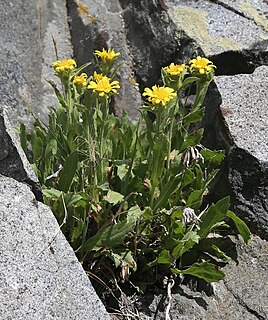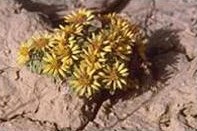
Townsendia is a genus of North American plants in the tribe Astereae within the family Asteraceae.
Erigeron breweri is a North American species of flowering plants in the daisy family known by the common name Brewer's fleabane.

Erigeron eatonii is a North American species of flowering plants in the daisy family known by the common name Eaton's fleabane.

Hulsea algida is a species of flowering plant in the daisy family, known by the common name Pacific hulsea or alpine gold.

Agoseris glauca is a North American species of flowering plants in the daisy family known by the common names false dandelion, pale agoseris, prairie agoseris, and short-beaked agoseris.

Agoseris grandiflora is a North American species of flowering plant in the daisy family known by the common names California dandelion, bigflower agoseris, and grassland agoseris.

Lessingia glandulifera is a species of flowering plant in the daisy family known by the common name valley lessingia. It is native to California and Baja California, where it grows in several types of habitat, from forest and desert to the coastline. This is an annual herb varying in maximum size from under 10 to nearly 80 centimeters in height, growing erect to decumbent. It is hairless to very hairy and glandular. The leaves are widely lance-shaped and toothed, the lowest approaching 11 centimeters in maximum length. The upper leaves are often studded with knobby glands. The flower heads appear singly at the tips of the stem branches. Each head is lined with phyllaries covered in large glands and sometimes many hairs. The head is discoid, containing no ray florets but many funnel-shaped disc florets with lobes that resemble ray florets. The disc florets are yellow with brown throats. The fruit is an achene with a whitish pappus.
Orochaenactis is a monotypic genus of flowering plants in the daisy family containing the single species Orochaenactis thysanocarpha, which is known by the common name California mountain pincushion. It is endemic to the southern Sierra Nevada of California, where it grows in the forests and meadows of the high mountains.

Pyrrocoma carthamoides is a species of flowering plant in the aster family known by the common name largeflower goldenweed. It is native to western North America from British Columbia to northeastern California to Wyoming, where it is known from grassland, woodlands, forests, barren areas, and other habitat. It is a perennial herb growing from a taproot and producing one or more stems to about half a meter in maximum length, the stems reddish-green and leafy. The largest leaves are at the base of the stem, measuring up to 20 centimeters long, lance-shaped with spiny sawtoothed edges. Leaves higher on the stem are smaller and hairier. The inflorescence is a single flower head or a cluster of up to four. Each bell-shaped head is lined with phyllaries each up to 2 centimeters long. It has many yellow disc florets surrounded by a fringe of yellow ray florets up to 7 millimeters long; ray florets are occasionally absent. The fruit is an achene which may be well over a centimeter in length including its pappus.

Selaginella densa is a species of spikemoss known by the common names lesser spikemoss, prairie spikemoss, and Rocky Mountains spikemoss. It is native to western North America, where it can be found from Alaska to Ontario, the Dakotas, Texas and far northern California.

Tonestus peirsonii is a local-endemic species of flowering plant in the aster family known by the common names Inyo tonestus, Peirson's serpentweed and Peirson's tonestus.
Townsendia leptotes is a species of flowering plant in the family Asteraceae known by the common names common Townsend daisy and slender townsendia. It is native to the western United States, where it grows in the alpine climates of high mountain ranges from California to Montana to New Mexico.

Townsendia scapigera is a species of flowering plant in the family Asteraceae known by the common name tufted Townsend daisy. It is native to the western United States, where it grows in mountains, sagebrush, and other habitat.

Townsendia aprica is a rare species of flowering plant in the family Asteraceae known by the common name Last Chance Townsend daisy. It is endemic to Utah in the United States, where it is known from three counties. It faces a number of threats and it is a federally listed threatened species of the United States.

Pyrrocoma clementis is a species of flowering plant in the aster family known by the common name tranquil goldenweed. It is native to Colorado, Utah, and Wyoming in the United States.
Physaria fremontii is a species of flowering plant in the family Brassicaceae known by the common name Fremont's bladderpod. It is endemic to Wyoming in the United States, where it occurs only in and around the Wind River Range in Fremont County.

Xanthisma coloradoense is a species of flowering plant in the aster family known by the common name Colorado tansyaster. It is native to Colorado and Wyoming in the United States.
Townsendia rothrockii is a species of flowering plant in the family Asteraceae known by the common name Rothrock's Townsend daisy. It is endemic to Colorado in the United States, where there are 35 occurrences across thirteen counties. Reports of the plant from New Mexico are false.

Erigeron leiomerus is a rare species of flowering plant in the daisy family known by the common names rockslide yellow fleabane or rockslide fleabane. It is native to the western United States, primarily in the Rocky Mountains and the Great Basin. It has been found in Montana, Idaho, Nevada, Utah, Wyoming, Colorado, and New Mexico.
Erigeron mancus is a rare North American species of flowering plant in the daisy family known by the common names depauperate fleabane and imperfect fleabane. It has been found only in southeastern Utah.














